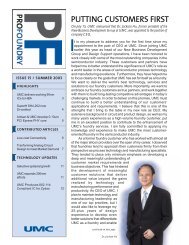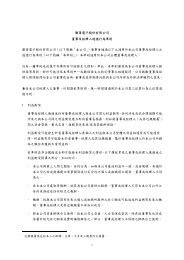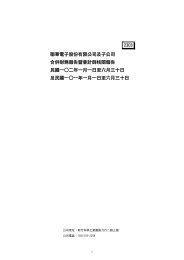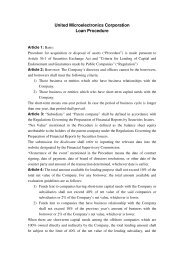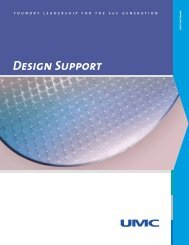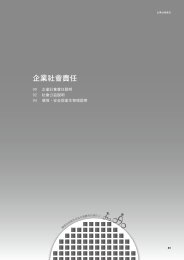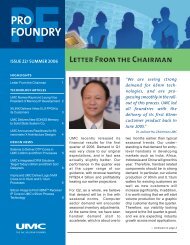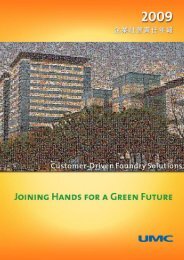Ch2 Sustainable Development - Environment - UMC
Ch2 Sustainable Development - Environment - UMC
Ch2 Sustainable Development - Environment - UMC
- No tags were found...
You also want an ePaper? Increase the reach of your titles
YUMPU automatically turns print PDFs into web optimized ePapers that Google loves.
Green Design<br />
In response to international environmental trends and customers’<br />
increasing demand for green products, <strong>UMC</strong> strives to raise its<br />
green competitiveness to maximize global opportunities. As a<br />
semiconductor foundry technology leader, <strong>UMC</strong>, although not<br />
producing its own branded end-products, continues to develop<br />
and employ low toxicity, low-power green product design and<br />
develop highly efficient, low-power production processes that<br />
minimize impact on the environment.<br />
Green Product Responsibility<br />
To ensure its products conform to international standards such<br />
as RoHS Directive (Restriction of the use of certain Hazardous<br />
Substances in electrical and electronic equipment) and<br />
customers’ requirements, <strong>UMC</strong> completed third-party verification<br />
on hazardous substances process management and has regular<br />
tests conducted by a third-party laboratory to make sure that<br />
<strong>UMC</strong> provides hazardous substance free products. Meanwhile,<br />
<strong>UMC</strong> has completed verifications of carbon footprint and water<br />
footprint to minimize the impact of its products as a way to fulfill<br />
its green product responsibility.<br />
2.5.3 Chemical Use<br />
Hazardous Substances Restrictions and Management<br />
To ensure its products conform to the EU’s RoHS Directive and<br />
customers’ requirements, <strong>UMC</strong> takes the following measures to<br />
control the use of hazardous substances:<br />
● Establish List of controlled Hazardous Substances<br />
<strong>UMC</strong> has established a hazardous substance control list<br />
based on international environmental protection laws and<br />
customers’ requirements. The list is regularly adjusted in line<br />
with international environmental regulations by expanding<br />
the application scope and controlled range of hazardous<br />
substances. By 2011, more than 200 substances were included<br />
in <strong>UMC</strong> Hazardous Substances control list.<br />
● Formulate Green Procurement Process of Raw Materials<br />
• <strong>UMC</strong>’s e-procurement system plays an important role in<br />
its green procurement management. Suppliers must upload<br />
their examination results for materials and goods through<br />
this platform, which allows <strong>UMC</strong> to identify items that violate<br />
applicable regulations in advance and take countermeasures<br />
immediately.<br />
• Hazardous substances control is also applied to material<br />
merchandising. All materials that violate the control will<br />
HSPM Committee Organization<br />
be deemed as disqualified products and returned to the<br />
suppliers, who are then required to provide correction and<br />
prevention measures.<br />
• Suppliers have to sign a guarantee agreement and provide<br />
third-party examination reports if necessary to ensure<br />
that their products meet the requirements of applicable<br />
environmental regulations.<br />
● Hazardous Substances Management Verification and Product<br />
Tests<br />
• <strong>UMC</strong> established a cross-divisional Hazardous Substances<br />
Process Management committee (HSPM committee) to<br />
improve the efficacy of green product management.<br />
47



